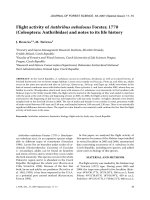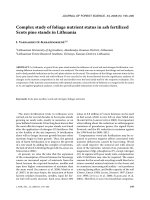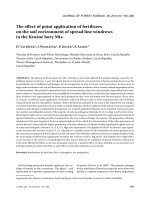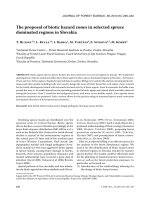Báo cáo lâm nghiệp: "Seasonal development of female strobilus of stone pine (Pinus pinea L.)" ppsx
Bạn đang xem bản rút gọn của tài liệu. Xem và tải ngay bản đầy đủ của tài liệu tại đây (287.75 KB, 3 trang )
Seasonal
development
of
female
strobilus
of
stone
pine
(Pinus
pinea
L.)
B.
Abellanas
J.A.
Pardos
Laboratory
of
Plant
Anatomy,
Physiology
and
Genetics,
E.T.S.
Ingenieros
de
Montes,
Ciudad
Universitaria,
28040
Madrid,
Spain
Introduction
The
stone
pine
(Pinus
pinea
L.)
prevails
as
a
fruit
tree
rather
than
as
a
timber
tree.
Therefore,
maximizing
cone
crops
must
be
a
primary
goal
for
breeding
perfor-
mance
(Pardos
and
Abellanas,
1988).
Establishment,
by
grafting,
of
clone
banks
from
selected
provenances
is
a
valid
way
to
progress
(Magini,
1965).
Precise
know-
ledge
of
the
4
yr
reproductive
cycle
of
this
species
is
necessary
for
an
accurate
eval-
uation
of
cone
production
and
manipula-
tion
of
the
selected
clones
in
the
banks.
The
object
of
the
research
described
herein
was
to
examine
the
morphology
of
the
female
strobilus
and
to
describe
the
phenology
of
the
reproductive
cycle
from
seed-cone
bud
initiation
to
appearance
of
the
embryo.
Materials
and
Methods
Female
strobili
and
potentially
reproductive
buds
were
collected
from
randomly
selected
P.
pinea
L.
grafts
growing
in
a
clone
bank
located
at
Castell6n, Spain.
Buds
and
strobili
were
taken
monthly
from
July
1987
to
July
1988,
fixed
in
FAA
(for-
malin-acetic
acid-ethanol),
and
stored
in
70%
ethanol
until
dissection.
Then
the
samples
were
dehydrated
and
embedded
in
paraffin.
Serial
microtome
sections
were
cut
7-9
pm
thick,
stained
with
safranin
and
fast-green,
and
examined
under
a
light
microscope.
Results
In
April,
just
after
flowering
occurred,
the
development
of
the
new
long-shoot
bud
begins.
The
apical
meristem
enlarges
and
initiates
primary
cataphylls
and
the
first
axillary
primordia.
In
July,
the
axillary
primordia
begin
to
form
secondary
cataphylls,
but
they
do
not
reach
the
differentiation
stage,
into
either
vegetative
or
reproductive
structures,
until
December.
During
December
and
Janua-
ry,
the
secondary
long-shoot
buds
diffe-
rentiate,
i.e.,
seed-cone
buds
and
lateral-
branch
buds
appear
on
the
upper
region
of
the
primary
long-shoot
bud.
February,
the
different
bud
types
are
distinct.
At
this
time,
the
female
buds
initiate
the
first
ovuliferous
scales.
How-
ever,
the
short-shoot
buds
are
still
undif-
ferentiated,
and
appear
as
simple
primor-
dia
covered
with
a
number
of
secondary
cataphylls.
They
continue
forming
new
cataphylls
until
March,
when
almost
all
the
ovuliferous
scales
have
appeared
and
the
ovules
begin
to
form
in
their
axils.
Around
late
March
or
early
April,
the
mature
seed-cone
buds
open
and
pol-
lination
takes
place.
Afterwards,
the
stro-
bilus
scales
enlarge
and
the
cone
closes.
Near
the
end
of
April,
a
hyaline
cell
appears
in
the
center
of
each
ovule.
Division
of
this
cell
initiates
the
spongy
tissue.
During
the
whole
next
year
of
development,
few
changes
in
the
ovule
occur;
the
spongy
tissue
enlarges,
the
pollen
tubes
grow
through
the
nucellus
and
the
different
layers
of
the
integument,
which
will
become
the
seed
coat,
begin
to
differentiate.
Not
until
February
of
the
third
year
of
development
does
the
free-nuclear
stage
of
the
female
gametophyte
appear
in
the
center
of
the
greatly
enlarged
spongy
tissue.
From
now
on,
the
development
of
the
female
gametophyte
is
very
fast.
During
the
next
month,
the
cell
wall
forms
and
separates
the
female
gametophyte
into
many
small
cells.
In
April,
the
archegonia
appear
at
the
nucellar
end
of
the
gametophyte,
with
the
egg
cell
well
formed.
In
early
June,
the
egg
cell
has
developed
large
vacuoles
and
soon
afterwards
fertilization
occurs.
In
mid-July,
the
embryo
begins
its
development,
which
will
be
finished
at
the
end
of
this
summer.
Discussion
and
Conclusion
The
stone
pine
(P.
pinea
L.)
has
a
peculiar
reproductive
cycle
because
it
takes
one
more
year
to
complete
than
most
of
other
Pinus
species
(Owens
and
Molder,
1984;
Pattinson
et al.,
1989).
The
main
conclusion
of
this
study
is
that
the
phases
of
female
strobilus
develop-
ment
in
this
species
are
similar
to
those
of
other
pines
but
the
timing
of
some
of
them
is
delayed.
The
first
steps
are
similar
but
female
gametophyte
development
and
fertilization
are
delayed
over
one
year.
References
Magini
E.
(1965)
Esperienze
sull’innesto
all’aperto
del
pino
domestico
(Pinus
pinea
L.).
Firenze, pp. 20
Owens
J.N.
&
Molder
M.
(1984)
The
re-
productive
cycle
of
Lodgepole
pine.
Information
Service
Branch,
Ministry
of
Forestry,
British
Columbia.
pp.
29
Pardos
J.A.
&
Abellanas
B.
(1988)
El
pino
pinonero:
especie
forestal
de
interds
fruticola.
Frut
Rev.
Fruticultura
3,
162-170
0
Pattinson
J.V.,
Burley
J.
&
Geary
TF.
(1969)
Development
of
the
ovulate
strobilus
in
Pinus
kesiya
Royle
ex
Gordon
(syn
Pinus
khasya
Royle)
in
relation
to
controlled
pollination
in
Zambia.
Silv.
Genet.
18,
108-111
l









